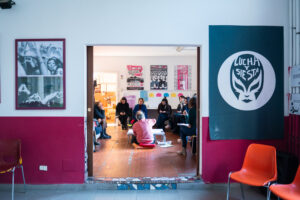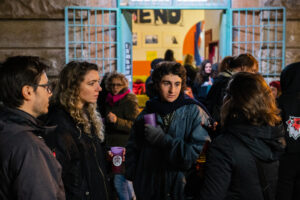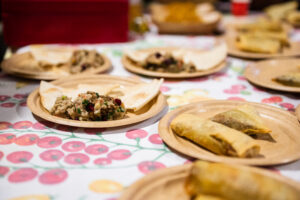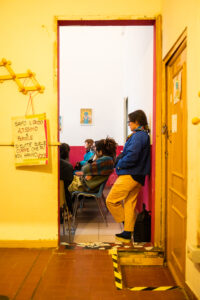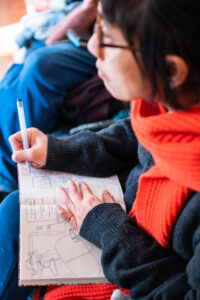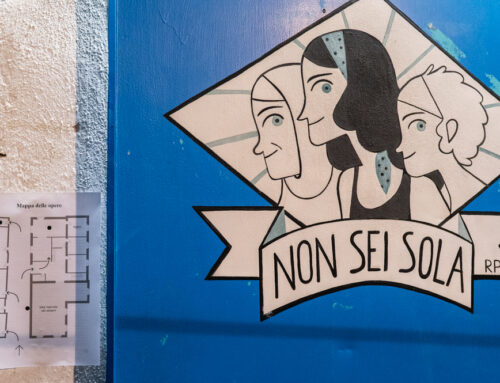Sense of Home
A Conversation about
Lucha y Siesta in Roma
Text by Yazan Khalili
I don’t remember who said what exactly; the conversation was like a ball passing from one speaker to the next; the articulate translator sitting beside me was translating into English what was being said by the different participants with the same low but audible voice, for me, it sounded like she was having a long monologue with different opposing ideas being put and built against each other. The contradictions and tensions seemed familiar to someone from Palestine, where the relationship between the governmental, non-governmental, civil, and grassroots organisations and institutions is an ongoing question and struggle between their histories, politics, and economic structures. What do we do with these institutions? How do we relate to them in the neoliberal economy? Do we stay in or out?
The roundtable discussion with several Italian activists, artists, researchers and cultural workers took place at Lucha y Siesta, a two-story house building in Rome squatted by a group of women. This unique space is offered to women to stay in and work, surrounded by a garden where people gather during and after every talk, coffee and cigarettes, sitting and standing, indoors and outdoors. The garden is surrounded by much higher buildings that overlook the house and the garden. It felt odd to have this house in the middle of such an area, resisting real estate development and gentrification, allowing for an open place to exist against the market and its economy.
Once I entered the house, I immediately felt at home as if it were in Palestine, as it resembled community spaces that managed to keep out from the speculation and monetary value, whether they were apartments in a building or a small building in the middle of a real estate development project, either by squatting, or having old cheap rent, or being leased by a family or a group member. They somehow look the same: collected furniture, multipurpose halls, posters, echoey space, different wall paint colours, DIY solutions, accumulation of processes, people and materials, plastic chairs, homemade food, and ad hoc exhibitions that are mostly centred around the exhibition itself as a place of gathering rather than the spectatorship of the artwork. In Palestine, I have been to many of such places; the Birzeit club in Birzeit town was the place where students gathered during the second intifada, the People’s Party office in the middle of what became the commercial centre of Ramallah that stood for a long time against the developers’ plans, the Ibda centre in Dehesha camp. These places have been the only spaces that accommodate discussions outside of the frameworks of the donors’ economy and their projects because they stay outside the economic grid of dependency and, therefore, can be the ground and the land of non-hierarchical discussions and disagreements.
The fact that the roundtable discussion took place at Lucha y Siesta is of immense importance in the current discourse on social change, decolonisation, the relationship between formal and informal institutions, and prefiguration and radical imagination. These topics have often been exploited and tokenised within the cultural field and institutions of the neoliberal economy, reducing them to mere rhetoric. However, discussing them in a p that actively challenges these structures brings them back to their roots, confronting them with the communities that are actively working and challenging the discourse of contemporary cultural production. This significance is not to be underestimated, as it underscores the urgency and the depth of the issues at hand.
I kept thinking what it means to be sitting a place that contains these struggles within it, the importance of solid places for any social and political movement against the fluidity of spaces in their contemporary use. Sara Ahmed writes: “To be part of a movement requires we find places to gather, meeting places. A movement is also a shelter. We convene; we have a convention. A movement comes into existence to transform what is in existence. A movement needs to take place somewhere. A movement is not just or only a movement; there is something that needs to be kept still, given a place, if we are moved to transform what is. “. (Ahmad, S. Living a feminist life, 2017:3). The concept of the space has been extensively used within the contemporary art practices, they are undefined, fluid, and can easily appear and disappear, much like the economy that produces them. Places on the otherhand, are physical grounds of gathering and convening are hard to create, and hard to keep, they are essential in building movements and allowing the accumulation of knowledge, bodies, and experiences. What Lucha y Siesta and similar places provide is the continuity and perseverance that is always challenged in an economy that demands for a new and fast products and ideas.
One speaker posed a crucial question that resonated deeply. Can we truly discuss decolonisation without delving into workers’ fees and work conditions? To unravel the complexities of colonialism, we must return to the core of capitalist exploitation and find ways to resist and subvert it. This necessitates a solid foundation, a space to accumulate the phases and bodies, and a platform to think through tangible examples and structures. The need for these elements is not just a theoretical construct, but a practical necessity in the process of decolonisation.
